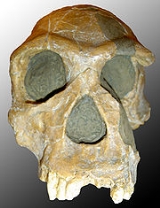
Homo habilis
Overview
Species
In biology, a species is one of the basic units of biological classification and a taxonomic rank. A species is often defined as a group of organisms capable of interbreeding and producing fertile offspring. While in many cases this definition is adequate, more precise or differing measures are...
of the genus Homo
Homo
Homo may refer to:*the Greek prefix ὅμο-, meaning "the same"*the Latin for man, human being*Homo, the taxonomical genus including modern humans...
, which lived from approximately at the beginning of the Pleistocene
Pleistocene
The Pleistocene is the epoch from 2,588,000 to 11,700 years BP that spans the world's recent period of repeated glaciations. The name pleistocene is derived from the Greek and ....
period. The discovery and description of this species is credited to both Mary
Mary Leakey
Mary Leakey was a British archaeologist and anthropologist, who discovered the first skull of a fossil ape on Rusinga Island and also a noted robust Australopithecine called Zinjanthropus at Olduvai. For much of her career she worked together with her husband, Louis Leakey, in Olduvai Gorge,...
and Louis Leakey
Louis Leakey
Louis Seymour Bazett Leakey was a British archaeologist and naturalist whose work was important in establishing human evolutionary development in Africa. He also played a major role in creating organizations for future research in Africa and for protecting wildlife there...
, who found fossil
Fossil
Fossils are the preserved remains or traces of animals , plants, and other organisms from the remote past...
s in Tanzania
Tanzania
The United Republic of Tanzania is a country in East Africa bordered by Kenya and Uganda to the north, Rwanda, Burundi, and the Democratic Republic of the Congo to the west, and Zambia, Malawi, and Mozambique to the south. The country's eastern borders lie on the Indian Ocean.Tanzania is a state...
, East Africa
East Africa
East Africa or Eastern Africa is the easterly region of the African continent, variably defined by geography or geopolitics. In the UN scheme of geographic regions, 19 territories constitute Eastern Africa:...
, between 1962 and 1964. Homo habilis (or possibly H. rudolfensis
Homo rudolfensis
Homo rudolfensis is a fossil human species discovered by Bernard Ngeneo, a member of a team led by anthropologist Richard Leakey and zoologist Meave Leakey in 1972, at Koobi Fora on the east side of Lake Rudolf in Kenya. The scientific name Pithecanthropus rudolfensis was proposed in 1978 by V. P...
) was the earliest known species of the genus Homo until May 2010, when H. gautengensis
Homo gautengensis
Homo gautengensis is a hominin species proposed by biological anthropologist Darren Curnoe in 2010. The species is composed of South African hominin fossils previously attributed to Homo habilis and is argued by some to be the earliest species in the genus Homo.-Discovery and analysis:Analysis...
was discovered, a species believed to be even older than H.
Unanswered Questions

